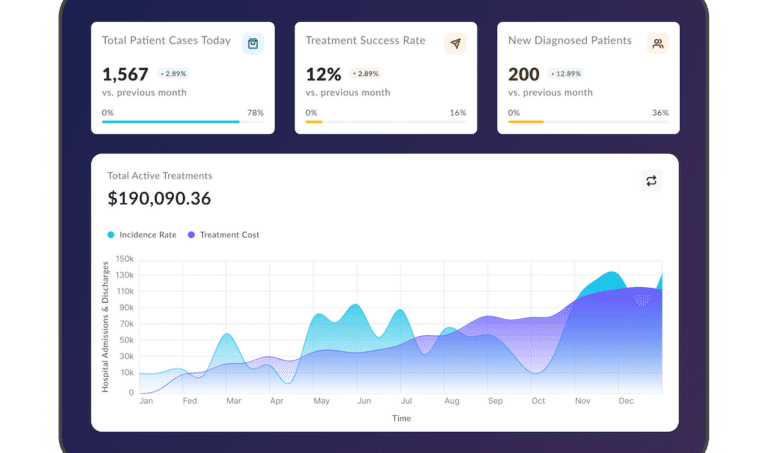AI Implementation: The Complete Roadmap
Updated: June 4, 2025
Artificial Intelligence (AI) has triggered a ripple effect in the business with its capabilities. No one wants to be left behind in this transformation – because AI implementation is an investment that adds business value, draws in more customers, and enables personalized product offerings. Such opportunities are too good to pass up.
But, even with all the excitement about it, it’s essential to remember that applying these technologies correctly can be tough. AI wears many hats – from machine to deep learning, predictive analytics to natural language processing, and computer vision to automation. Therefore, having a solid AI implementation plan, along with the necessary skills and resources, is crucial. These elements could make or break your AI system’s success.

We provide companies with senior tech talent and product development expertise to build world-class software. Let's talk about how we can help you.
Contact usTable of Contents
Understanding AI and Its Potential
AI for businesses is not only about automating tasks. It’s about reimagining how you operate, compete, and win. Let’s reveal the transformative power of AI and how it can unlock your company’s true potential:
Efficiency Unleashed
Imagine a world where AI tools solve everyday problems, freeing your employees to strategize, innovate, and create. AI automates repetitive tasks, from data entry to customer service, allowing your human talent to focus on what truly matters. Think chatbots answering questions 24/7 while your customer service team tackles complex issues with a smile. The result? Increased productivity, reduced costs, and a happier, more fulfilled workforce.
Data-Driven Decisions, Every Time
Say goodbye to intuition and guesswork. AI analyzes huge amounts of data – your customers, market, and operations – and translates it into actionable insights. Predictive analytics anticipate trends, optimize resource allocation, and guide you toward the most profitable decisions. You’re not just reacting to the market but shaping it by making one smart choice after another.
Growth Beyond Borders
AI personalizes experiences, expands your reach, and reveals hidden opportunities. Imagine tailoring product recommendations and marketing campaigns to individual preferences, like a genie whispering secrets in your customers’ ears. See new market segments emerge from the data, waiting to be explored. AI fuels revenue growth, market expansion, and a globalized customer base.
Customer Experience Revolutionized
Forget faceless transactions. AI analyzes preferences and behaviors, crafting personalized experiences that make every interaction feel like a warm welcome. Think virtual assistants resolving issues instantly, offering tailored recommendations, and even remembering your coffee order. That isn’t just service; it’s building relationships, loyalty, and a brand that customers truly love.
Innovation, Built-in
AI isn’t just a tool; it’s an accelerator for innovation. It analyzes data to identify new product ideas, streamlines R&D processes, and even predicts product failures before they happen. This continuous cycle of improvement keeps you ahead of the curve, ensuring your offerings are always fresh, relevant, and ahead of the competition.
Preparing for the Implementation of AI
Before blasting off into the AI stratosphere, checking your systems and fuel gauges is crucial. Here are steps for a hassle-free and successful implementation:

Assess Organizational Readiness
- Infrastructure: Can your servers handle the computational demands of AI algorithms? Large models can require significant processing power, so be sure your servers are up to the task. Do you have the storage capacity for data influx? Evaluate cloud-based alternatives that can scale and adjust as per your needs.
- Skills: Does your team possess the necessary expertise in data science, machine learning, or AI-specific tools? This expertise is crucial for selecting relevant data, interpreting results, and ensuring AI models are aligned with your business goals. Consider internal training programs or hiring external consultants to fill any skill gaps.
- Resources: Are you prepared to invest in AI technology, software, and ongoing maintenance? Consider the costs of software, hardware upgrades, data storage, and potential consulting fees. Remember, AI is a lasting investment, so budget the cost of AI implementation accordingly. Prepare to allocate resources for your AI software development project planning, development, testing, and ongoing maintenance.
Build a Cross-Functional Team
An AI project isn’t a solo mission. Assemble a team with diverse expertise, including:
- Business leaders: They set the strategic direction and ensure the AI project aligns seamlessly with overall business goals.
- IT specialists: The backbone of the technical side, they create AI solutions and provide essential infrastructure and ongoing support.
- Data scientists: Experts in data manipulation, they excel in analyzing extensive data and developing and perfecting AI models.
- Domain experts: They offer invaluable insights that help tailor the AI models to specific business contexts.
- Project managers: By simplifying complex technical jargon into understandable business language, they ensure all stakeholders are on the same page, facilitating better decision-making and project cohesion.
Identify Potential AI Use Cases
Don’t just throw AI at every problem. It would be best to recognize specific areas where AI can deliver tangible value. Consider:
- Repetitive tasks: Can AI automate data entry, customer service inquiries, or routine reports?
- Data-driven decision-making: Can AI analyze data to predict customer behavior, optimize pricing strategies, or identify market trends?
- Personalization: Can AI personalize product recommendations, marketing messages, or customer support interactions?
Develop an AI implementation Strategy
Don’t let your AI journey be rudderless. Develop a clear AI implementation roadmap with the following:
- Objectives: What do you want to achieve with AI? Define measurable metrics to track success.
- Timeline: Set realistic milestones for development, deployment, and scaling.
- Budget: Allocate resources efficiently for technology, training, and ongoing maintenance.
- Risk mitigation plan: Spot potential AI implementation challenges and develop strategies to address them.
Choose the Right AI Model
There’s no one-size-fits-all AI solution. Carefully evaluate:
- Pre-trained models: Existing models trained on specific tasks can be a quick and cost-effective option.
- Custom development: Building your own AI model offers greater control and customization but requires significant resources.
- Hybrid approach: Combine pre-trained models with custom development for specific needs.
The implementation of AI is an ongoing journey. Be prepared to adapt, learn, and refine your approach as you progress.
Implementation Process
With AI strategy in place, let’s navigate the essential phases:

1. Data Splitting for Training and Testing
Like a rocket needs fuel, your AI model needs data to learn and grow. However, not all data is created equal. Data splitting ensures your model receives the right fuel for optimal performance:
- Training data: This larger portion (60-80%) teaches your model the patterns and relationships within your data.
- Validation data: This smaller set (10-20%) helps you fine-tune hyperparameters and avoid overfitting.
- Test data: This untouched portion (10-20%) serves as a true test of your model’s real-world performance.
Choose your data splits carefully, ensuring diversity and representativeness to avoid biased models.
2. Model Training and Evaluation
Now, it’s time to train an AI model. Popular options include:
- Supervised learning: Your model learns from labeled data, like predicting customer churn based on past behavior.
- Unsupervised learning: Your model discovers patterns in unlabeled data, like clustering customer segments based on purchase history.
- Reinforcement learning: Your model learns through trial and error, like optimizing delivery routes by rewarding successful decisions.
Train your model iteratively, evaluating its performance on the validation data. Adjust hyperparameters, tweak algorithms, and collect more data if needed. Remember, a well-trained model is a confident pilot!
Your next read: Right Language for AI
3. Deployment and Integration
Once your model is trained, it’s time to launch it into your business ecosystem. Choose a deployment strategy based on your needs:
- On-premise: Host the model on your own servers for maximum control and security.
- Cloud-based: Leverage cloud platforms for scalability and cost-effectiveness.
- Hybrid approach: Combine on-premise and cloud deployment for specific requirements.
Integrate your AI model into existing workflows seamlessly. Provide clear user interfaces and training for teams to interact effectively with AI. Remember, a smooth landing is crucial for a successful mission!
4. Monitoring and Maintenance
AI models aren’t static; they need continuous monitoring and maintenance to stay on track. Here’s how to ensure your AI remains mission-ready:
- Monitor performance: Track key metrics aligned with your objectives to identify any performance degradation.
- Data fluctuation: Stay alert to changes in data distribution and retrain your model to ensure continued precision.
- Bias detection: Regularly assess your model for potential biases and implement mitigation strategies.
- Security updates: Stay updated on security vulnerabilities and patch your AI system promptly.
By proactively monitoring and maintaining your AI, you can ensure its long-term success and prevent potential crashes.
Key Technologies Powering AI
There are over 300K models published on HuggingFace, over 50% of popular GitHub repositories are dedicated to AI, and over 8,000 AI applications have already been created.
But what are the key drivers behind AI advancement?

Machine Learning and Deep Learning
Machine learning (ML) is the core engine of most AI applications. It enables computers to learn from data without explicit programming, making predictions and improving over time. Deep learning, a subset of ML, uses artificial neural networks inspired by the human brain, allowing them to handle complex tasks like image recognition and natural language processing.
Natural Language Processing
Natural language processing (NLP) allows computers to understand and process human language. It includes tasks like speech recognition, text analysis, and machine translation. NLP unlocks a wealth of data trapped in text and audio, enabling richer interactions with AI systems.
Robotics and Automation
Robotics and automation take physical action on the decisions made by AI models. From industrial robots performing intricate tasks to autonomous vehicles navigating complex environments, these technologies extend the reach of AI into the physical world.
These technologies aren’t mutually exclusive; they often work together to power AI solutions.
Overcoming Challenges in AI Implementation
Even the most meticulous preparation can’t guarantee a smooth ride through the AI space. But with the right tools and knowledge, you can steer through these obstacles and make your AI implementation strategy successful.
Data Quality and Management
Garbage in, garbage out. Poor-quality data can reduce your AI model’s performance, leading to inaccurate predictions and biased outputs. Here’s how to ensure your data is fit for flight:
- Cleanliness: Address missing values, inconsistencies, and outliers to ensure data integrity.
- Relevance: Select data aligned with your AI goals and avoid irrelevant noise.
- Security: Implement strong data governance practices to protect sensitive information.
- Accessibility: Ensure your data is readily available and organized for efficient model training and updates.
Remember, data quality is the foundation of your AI project. Invest in robust data management tools and practices to ensure your model operates at peak efficiency.
Talent Acquisition and Training
AI is a team sport, and finding the right talent is crucial. It would be best to hire AI engineers and data scientists with specific industry knowledge. Consider these strategies:
- Internal training: Upskill existing employees with relevant AI skills to bridge the talent gap.
- Partnerships and collaborations: Leverage external expertise through partnerships or consulting services.
- Attracting AI talent: Create a competitive environment and offer attractive career paths for AI professionals.
A skilled and motivated team is your mission control. Foster a continuous learning and collaboration culture to keep your AI initiatives skyrocketing.
Scalability and Integration Challenges
Scaling your AI model from a small test to a large-scale deployment can be tricky. Here are some tips for a smooth transition:
- Infrastructure: Choose scalable cloud platforms or invest in robust on-premises infrastructure to handle increased data volume and processing demands.
- Model optimization: Refine your model to improve efficiency and reduce the computational resources needed.
- Integration with existing systems: Ensure seamless integration of your AI model with your existing workflows and data pipelines to avoid disruption.
By addressing these key challenges, you can navigate the implementation turbulence and ensure your mission reaches its full potential.
Successful Cases of AI Implementation
Now that you’ve navigated the implementation challenges, it’s time to witness the power of AI in action. Let’s explore real-world AI implementation examples of how different industries are leveraging it to achieve remarkable results:

AI in Healthcare
AI helps detect early diseases like cancer and heart conditions, leading to better treatment results. It also customizes treatments based on patient data and genetics for more effective therapy. AI chatbots offer continuous support, handling patient queries and scheduling, easing healthcare professionals’ workload.
Example: DeepMind’s AI model accurately predicts the onset of acute kidney injury in patients, allowing doctors to take preventive measures and improve patient outcomes.
AI in Financial Services
In fintech, AI detects fraud by analyzing transactions and behaviors, protecting against losses. It also predicts market trends for automated trading and provides personalized financial advice and investment strategies through chatbots and robo-advisors.
Example: Goldman Sachs’ AI platform, Kensho, analyzes vast amounts of data to generate market insights and investment recommendations, helping clients make informed financial decisions.
AI in Retail
AI analyzes customer history and behavior in retail to suggest products and deals, increasing sales and satisfaction. It dynamically adjusts prices based on demand and market trends, enhancing revenue. AI also forecasts demand and manages inventory, cutting waste and ensuring product availability, which lowers costs and boosts customer contentment.
Example: Amazon’s recommendation engine, powered by AI, makes personalized product suggestions for each customer, leading to higher conversion rates and customer loyalty.
Key Takeaways
The success of the implementation of AI largely depends on having labeled data, a solid data pipeline, suitable models, and the right team to build the solution. Once these needs are met, you can follow a step-by-step process to develop effective AI models.
Are you looking for AI development services? Our team, including AI engineers, data scientists, developers, UI/UX designers, and DevOps experts, can create impactful AI solutions that bring your business value. For expert assistance in AI implementation projects, contact us.
Our core services:
Do you want a price estimate for your project?
Do you know that we helped 200+ companies build web/mobile apps and scale dev teams?
Let's talk about your engineering needs.
Write to us











